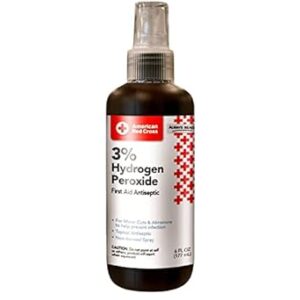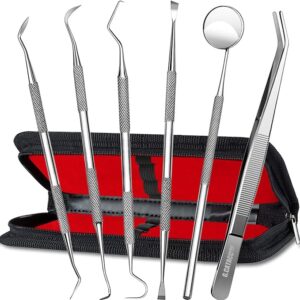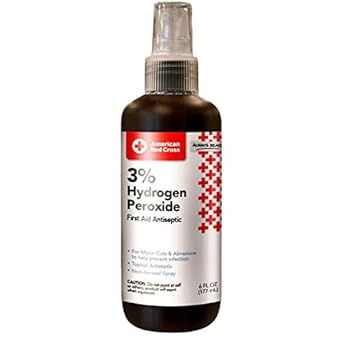What is gingivitis in a cat?
Inflamed gums in cats, also known as gingivitis, is an inflammation of the gums around the teeth in your cat’s mouth. This inflammation is usually a result of plaque buildup on the teeth. It is a sticky layer of food residues in which bacteria grow. Minerals can also precipitate in this dental plaque over time. This causes tartar to form. Even more bacteria grow in this tartar and the tartar pushes the gums away and cause them to get inflamed. This in its turn wil cause the roots of teeth to become loose. Resulting in loss of teeth and molars. Not to mention the pain that the gingivitis causes.
But gingivitis in cats can also be caused by a little wound in the mouth that has become infected. In particular, after a fight or an accident with a vehicle, wounds can occur. These wounds sometimes become infected by the bacteria that normally live in your cat’s mouth. Resulting in gingivitis in your cat. Usually you have already noticed some small wounds on the rest of his body if this is the cause for your cat’s gingivitis.
Rarer causes of gingivitis in cats are cat flu or immune-suppressing diseases such as feline AIDS (FIV) or the leukemia virus (FeLV). But kidney failure also causes gums to become quite inflamed.
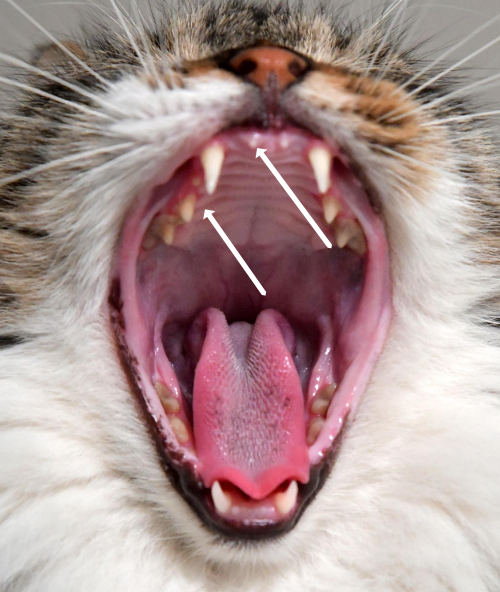
Symptoms of gingivitis in cats
In mild cases, you actually notice very little about your cat when it suffers from gingivitis. Cats with a mild form of gingivitis, will only have gums that look red and inflamed. In most cases, this will be discovered when your cat visits your veterinarian and gets a full check-up before getting their cat distemper and cat flu vaccine.
Cats have a lot of pain from their gingivitis in severe cases. They will have a harder time eating if they have an intense gingivitis. They “throw” food in their mouth from one side to the other. Or they take a bite, are startled by the pain while eating and then do not dare to continue eating. In addition, you also see that they start drooling or that they stick their tongue hang out of their mouths. In some cases, cats also rub their paws against their mouths. Usually there is also a pretty foul smell coming from your cat’s mouth. As a result of the pain in their mouth, they also wash themselves less, which results in a poor coat condition. In addition, they sometimes are quite grumpy as a result of the pain and poor sleep.
How do you notice that a cat is in pain?
Unfortunately, in many cases you don’t notice anything at all. Cats are sometimes quite tough when it comes to inflamed gums. But in severe cases, your cat behaves differently while eating when there is gingivitis. After all, it hurts him a lot. As a result, you sometimes see that they lose some weight after a few weeks of less food intake or that they rub their mouth with a paw. In some cases, you also see blood on their mouths. And of course, their fur can also start to look unkept.
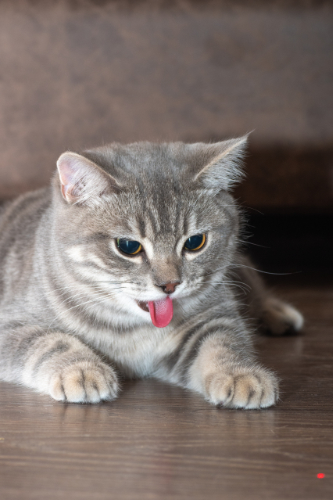
Can gingivitis resolve on it's own?
That is possible, but usually not the case. If, for example, the cause of the inflammation of the gums is tartar, this inflammation will only go away when the tartar has dissolved. That is, until the tartar has been removed by a vet or until the tooth has fallen out with tartar and all.
Even when a wound in the gums has become inflamed, your cat will not easily get it under control. But it is certainly not impossible. However, it is wiser to help your cat with treatment. That way it at least resolves faster.
What soothes gingivitis?
Anything that prevents bacterial growth will improve the inflamed gums. To soothe inflamed gums, we prefer to use hydrogen peroxide 3% solution twice a day for at least 5 days, but possibly a little longer. Put it on a cotton swab (do not spray it, your cat will be scared of that sound!) and dab the gingivitis area. If it didn’t resolve after 10 days, something is not right and it is wise to take your cat to your vet. He will hopefully find the cause for the gingivitis and give medication for it.
Is gingivitis in your cat contagious?
Gingivitis itself in cats is not contagious. But there are germs that cause gum inflammation, such as cat flu, feline AIDS or feline leukemia. Of course these germs are contagious and make other cats ill. But most causes of gum disease are not contagious.
Geriatric cat with gingivitis
Older cats have been able to accumulate minerals in their dental plaque for years. This created tartar on his teeth. It can have taken extreme forms where the tartar can get in the way and irritate the gums. As a result, old cats suffer from gingivitis more often than young cats. Although it also occurs regularly in young cats.
In addition, renal function may be impaired in older cats. In this case waste products will accumulate in the cat’s body. These waste products are therefore elevated in all places, including places where many bacteria normally live, such as in your cat’s mouth and gastrointestinal tract. Bacteria grow well when these waste products are present in their habitat in increased quantities. This makes infections more likely to occur. So in an old cat with gingivitis, it is also wise to examine the kidney function by means of a blood test.
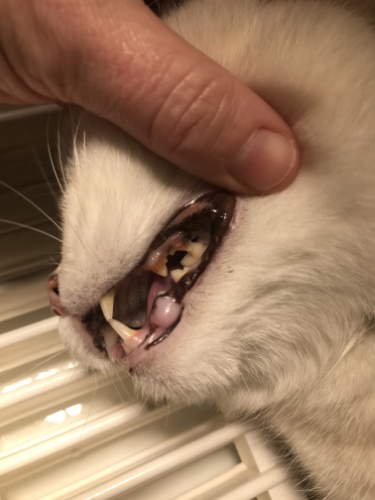
Juvenile gingivitis in a cat
In young cats, the condition juvenile gingivitis also occurs. Better known as gingivitis-stomatitis complex. This creates a pretty intense form of inflamed gums in this young cat. This usually occurs just after the adult teeth came through. It is believed to be some sort of allergic reaction to tooth enamel.
In cats with this condition, we first try out quite a few treatments, but very often end up with the complete removal of all teeth except for the large canines. If the problem is still not completely solved after the removal of the molars, we even pull out the canine teeth. This seems like a very tough decision, but the cats are in so much pain for so long that something needs to be done. They usually recover extremely quickly after the teeth are extracted. When their pain is gone you see them blossoming day by day. You don’t even want to think about having this terrible pain in your mouth for months, right?
Tips about what to do with a cat with gingivitis?
First of all, you should see if there is a lot of tartar on your cat’s teeth. You do this by lifting his lips and also pulling back a bit. You will then see his teeth and molars appear. Is there a lot of dark brown stuff on the molars or teeth here? Then this is most likely the cause of your cat’s inflamed gums. If the gingivitis is not too extreme and your cat is of the cooperative type (yes, they exist!) then you can try to “scratch” his teeth clean with a tartar scraper. First try to scratch his molars with your nails. If that doesn’t work, then a tartar scraper won’t work either.
If your cat decides to cooperate, scrape off any brown hard substance from the teeth. Especially the tartar that lies against the gums. Start with the teeth or molars near the worst gingivitis. Do one tooth every few days and reward your cat after scratching with the most delicious “candy” you can think of for him. That way he will want to cooperate again next time. As soon as the teeth are clean again, he should no longer have gum inflammation. Incidentally, it can start to bleed a little in your cat’s mouth when you touch the inflamed gums. Try to damage and touch the gums as little as possible because it hurts him. But if it starts to bleed a little, don’t worry too much. It will stop by itself.
Medication against gingivitis in cats
If you want to give medication against gum disease, you can use hydrogen peroxide 3%. You put this on a cotton swab and dab this twice a day for 5-10 days on the inflammation of the gums in your cat. Your cat’s gum inflammation should soon start to improve.
All other forms of medication that will help with gingivitis in your cat can only be obtained after you have visited your vet. Think of antibiotics, anti-inflammatories, and in rare cases interferons. You cannot purchase this medication yourself without a prescription from a veterinarian. So if the hexagel is not sufficient enough, you will unfortunately still have to visit your vet. But you can also try if Vet One ChloraZinc Rinse works for your cat. It is a different kind of anti-bacterial treatment as the hydrogen peroxide, but with about the same strenght. So don’t expect to much of it if hydrogen peroxide didn’t work before. But it is worth a try. This solution is also used twice a day for at least 5 days. Cat’s don’t like it when you spray it on their tongue, so use a cotton swab for it.
When should you go to the vet with gingivitis in your cat?
If your cat has a lot of pain in its mouth, it is wise to go to your vet right away. He or she can give your cat a painkiller and also determine the cause of the inflammation in his gums. If the cause of the inflammation is tartar, he or she will suggest a tartar treatment. In serious cases, they will unfortunately sometimes have to pull teeth. If your vet suspects a different cause, he can choose a different approach. Consider, for example, a blood test to determine feline AIDS, feline leukemia or kidney failure.
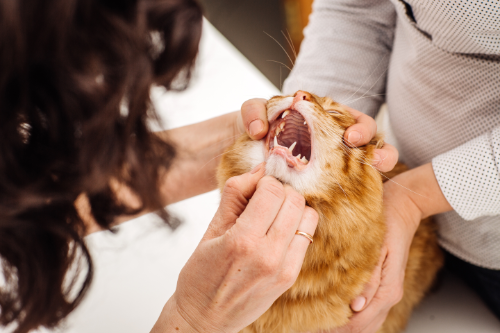
Costs of treating inflamed gums in cats
It goes without saying that the costs depend on the cause of your cat’s inflamed gums and the country you live in. With a complete dental cleaning and pulling some teeth, you can easily look at € 400,- to 500,-. But if only an anti-inflammatory and a course of antibiotics are required, the costs will be approximately €75,-. However, the most expensive treatment is when a cat’s teeth completely have to be pulled from a young cat. This can be anywhere from €700 to €1000. And even then, there are not many vets who perform this treatment. I can tell you that it is a terribly difficult, very tiring and time-consuming job. Many veterinarians prefer to refer you to a dentist for animals. But hopefully that’s not necessary for your cat.

